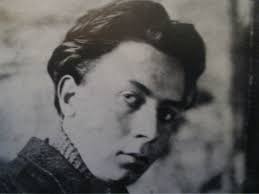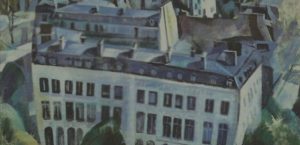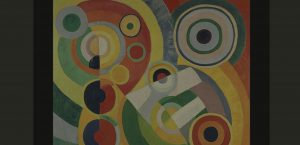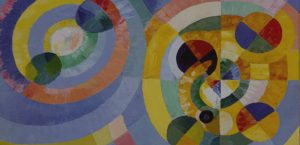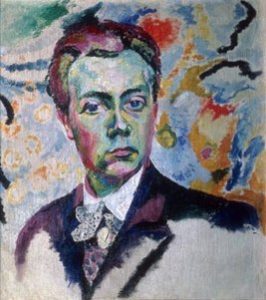Robert Delaunay was born on the 12th of April in 1885 in Paris.
1885 - 1941
Robert Delaunay
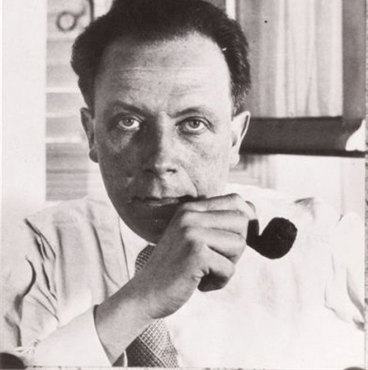
description
A French painter and art theorist, a pioneer of European abstract painting.
He was born into the family of a railway engineer. Soon his parents divorced; his relatives on the maternal line brought up the boy. Noticing Robert’s penchant for fine art, his uncle sent him to study at the art studio of Roncin, where he learned to create theatrical scenery and stage design.
Robert Delaunay was one of the brightest Cubist artists, a member of the “Golden Section” group, who influenced many of his colleagues. In collaboration with his wife, Sonya Delaunay, he developed his own version of Cubism, based on the scientific color theory of chemist E. Chevreuil, which was called “Orphism” by critic G. Apollinaire. Delaunay was always at the very center of the avant-garde art movements in Paris, was close to the participants of the Munich group “Der Blaue Reiter”, participated in their joint exhibition in 1911. The master created costumes for Diaghilev’s ballet designed one of the pavilions at the world exhibition in Paris in 1937. The many-sided and bright creativity of the artist, permeated with dynamics and modern pace of life, attests to his high skill and outstanding talent.
Key ideas:
– The artistic style of Robert Delaunay is a special phenomenon in the fine arts of the early twentieth century. His works are a unique fusion of new European art trends with his own interpretation of perspective and spatial relations in painting. The faceted compositions of Delaunay’s Cubism, permeated with bright color and optimism, are a direct reflection of the dynamics and pace of the world that was contemporary for the artist.
– A special place in Delaunay’s work was always taken by color and light. Like the rest of the Cubists, he tried to solve the problem of discrepancy between the shape of objects and their color, but did it in a completely different way. Instead of ignoring the color, as the adherents of Analytical Cubism did, he tried to depict the object and its position in space with its help.
– In his paintings, the artist managed to convey the perspective, lighting and movement of objects with the help of one color only, fully revealing their interaction in the picture. Thus, Robert Delaunay became the pioneer of a completely new painting style, which was called “Orphism” by his friend Apollinaire for its bright and pure sound and a special harmony of color combinations.
– To achieve the important effect of dynamics and rhythm, the artist used special techniques. He completely moved away from the line, considering this method of image transmission too simple and obsolete, and turned to color contrasts that served as the boundaries of forms. In addition, Delaunay used repeatedly repeated geometric shapes – circles, disks and rectangles – in his paintings.
– Starting from the depiction of recognizable objects, such as the Eiffel Tower, cityscapes and portraits, Delaunay gradually moved on to a complete abstraction. While you can still see the outlines of the window or the human figure in the pictures of the transition period, the samples of the mature style consist only of bright color contrasts and abstract geometric shapes intersecting at different angles. Running rhythms and saturated colors cause a sense of movement, vibration and even a slight dizziness in the viewer. This impression fully corresponded to the new worldview of people in the artist’s epoch, when the rhythm of life accelerated before our eyes, the old ideas of time, space and structure of objects collapsed.
1885
1903
1909
1915 - 1920
1930
1941
The birth of the artist
Visited Brittany
Visited Brittany, where an art school of Pont-Aven existed a few decades before. Inspired by the legacy of Gauguin, Delaunay worked on a series of Post-impressionist landscapes. Here he met A. Rousseau, who became for him a kind of spiritual mentor. Upon his return to Paris, Delaunay was fond of the art of the Neo-Impressionists and, together with J. Metzinger, was engaged in experiments in the technique of pointillism.
Met young and talented artist Sonia Stern
Met young and talented artist Sonia Stern, who became his wife and companion for many years. Together with his wife, Delaunay continued to study the optical properties of color, became close to the group of Cubists and exhibited his works at the 41st gallery of the Salon of Independent in 1911. The exposition was the first joint exhibition of the Cubists. In the same year, the artist met W. Kandinsky, who invited him to take part in the Munich exhibition of the group. Over the next few years, the artist became one of the central figures of European avant-garde painting.
He spent the years of war in Portugal and Spain
He spent the years of war in Portugal and Spain, where he actively collaborated with S. Diaghilev’s ballet company. At this time, his wife Sonia became a famous fashion designer. Upon their return to Paris, the couple opened several fashionable boutiques and became successful businessmen. In the 1920s, the avant-garde artists gathered in their apartment every week. They were Cubists, Surrealists and Dadaists: F. Picabia, A. Breton, Jean and Sophie Arp, V. Baranov-Rossini and others. The style of painting Delaunay at this time became more abstract.
The artist participated in several monumental projects
He created several series of abstract canvases, such as “Color rhythms”, “Infinite rhythms”, “Joy of life”. The artist participated in several monumental projects, such as the huge painting “Rhythm” in the air hall for the Paris International Exhibition of 1937. He also created printed graphics and posters.
The death of the artist
He died on the 25th of October in 1941 in Montpellier, France.
Robert Delaunay
On Artist
flow
Impressionism
Neo-impressionism
Post-impressionism
Fauvism
Cubism
friends
Fernand Leger
Jean Metzinger
Henri Le Foconier
Albert Gleze
artists
Paul Cezanne
Georges Cera
Vincent van Gogh
Henri Matisse
Pablo Picasso
George Braque
Henri Rousseau
Claude Monet
By Artist
flow
Orphism
Suprematism
Abstract expressionism
Abstractionism
friends
Wassily Kandinsky
Franz Marc
Vladimir Baranov-Rossine
Francis Picabia
Marcel Duchamp
Andre Breton
Sonya Delone
Fernand Leger
Jean Metzinger
Roman Yulianovich Selsky
Margarita Ivanovna Selskaya-Reich
Jozef Pankevich
artists
Paul Klee
Augustus Macke
Aristarkh Lentulov
Mark Shagal
Diego Rivera
Alfio Giuffrida

